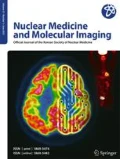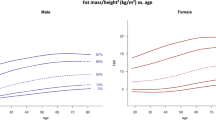Abstract
Purpose
The purpose of this study was to estimate lean body mass (LBM) using CT (LBM CTs) and compare the results with LBM estimates of four different predictive equations (LBM PEs) to assess whether LBM CTs and LBM PEs can be used interchangeably for SUV normalization.
Methods
Whole-body F-18 FDG PET/CT studies were conducted on 392 patients. LBM CT1 is modified adipose tissue-free body mass, and LBM CT2 is adipose tissue-free body mass. Four different PEs were used for comparison (LBM PE1–4). Agreement between the two measurement methods was assessed by Bland-Altman analysis. We calculated the difference between two methods (bias), the percentage of difference, and the limits of agreement, expressed as a percentage.
Results
For LBM CTs vs. LBM PEs, except LBM PE3, the ranges of biases and limits of agreement were −3.77 to 3.81 kg and 26.60–35.05 %, respectively, indicating the wide limits of agreement and differing magnitudes of bias. For LBM CTs vs. LBM PE3, LBM PE3 had wider limits of agreement and greater positive bias (44.28–46.19 % and 10.49 to 14.04 kg, respectively), showing unacceptably large discrepancies between LBM CTs and LBM PE3.
Conclusion
This study demonstrated that there are substantial discrepancies between individual LBM CTs and LBM PEs, and this should be taken into account when LBM CTs and LBM PEs are used interchangeably between patients.



Similar content being viewed by others
References
Wahl RL, Jacene H, Kasamon Y, Lodge MA. From RECIST to PERCIST: evolving considerations for PET response criteria in solid tumors. J Nucl Med: Off Publ So Nucl Med. 2009;50 Suppl 1:122S–50S.
James WPT. Research on obesity. London: Her Majesty’s Stationery Office; 1976. p. 8–12.
Deurenberg P, Weststrate JA, Seidell JC. Body mass index as a measure of body fatness: age- and sex-specific prediction formulas. Br J Nutr. 1991;65(2):105–14.
Devine B. Gentamicin therapy. Drug Intell Clin Pharm. 1974;8:650–5.
Gallagher D, Heymsfield SB, Heo M, Jebb SA, Murgatroyd PR, Sakamoto Y. Healthy percentage body fat ranges: an approach for developing guidelines based on body mass index. Am J Clin Nutr. 2000;72(3):694–701.
Bellisari A, Roche AF. Anthropometry and ultrasound. In: Heymsfield SB, Lohman TG, Wang Z, Going SB, editors. Human body composition. Champaign: Human Kinetics; 2005. p. 109–27.
Chowdhury B, Sjostrom L, Alpsten M, Kostanty J, Kvist H, Lofgren R. A multicompartment body composition technique based on computerized tomography. Int J Obes Relat Metab Disord: J Int Assoc tudy of Obes. 1994;18(4):219–34.
Shen W, St-Onge MP, Wang Z, Heymsfield SB. Study of body composition: an overview. In: Heymsfield SB, Lohman TG, Wang Z, Going SB, editors. Human body composition. Champaign: Human Kinetics; 2005. p. 3–14.
Wang ZM, Pierson Jr RN, Heymsfield SB. The five-level model: a new approach to organizing body-composition research. Am J Clin Nutr. 1992;56(1):19–28.
Basic anatomical and physiological data for use in radiological protection: reference values. A report of age- and gender-related differences in the anatomical and physiological characteristics of reference individuals. ICRP Publication 89. Annals of the ICRP. 2002;32(3–4):18–9, 72–6, 205–6.
Shen W, Wang Z, Punyanita M, Lei J, Sinav A, Kral JG, et al. Adipose tissue quantification by imaging methods: a proposed classification. Obes Res. 2003;11(1):5–16.
Ross R, Leger L, Guardo R, De Guise J, Pike BG. Adipose tissue volume measured by magnetic resonance imaging and computerized tomography in rats. J Appl Physiol (Bethesda, MD: 1985). 1991;70(5):2164–72.
Mitsiopoulos N, Baumgartner RN, Heymsfield SB, Lyons W, Gallagher D, Ross R. Cadaver validation of skeletal muscle measurement by magnetic resonance imaging and computerized tomography. J Appl Physiol (Bethesda, MD: 1985). 1998;85(1):115–22.
Rossner S, Bo WJ, Hiltbrandt E, Hinson W, Karstaedt N, Santago P, et al. Adipose tissue determinations in cadavers—a comparison between cross-sectional planimetry and computed tomography. Int J Obes. 1990;14(10):893–902.
Seidell JC, Bakker CJ, van der Kooy K. Imaging techniques for measuring adipose-tissue distribution–a comparison between computed tomography and 1.5-T magnetic resonance. Am J Clin Nutr. 1990;51(6):953–7.
Sjostrom L, Kvist H, Cederblad A, Tylen U. Determination of total adipose tissue and body fat in women by computed tomography, 40K, and tritium. Am J Physiol. 1986;250(6 Pt 1):E736–45.
Mattsson S, Thomas BJ. Development of methods for body composition studies. Phys Med Biol. 2006;51(13):R203–28.
Ross R. Advances in the application of imaging methods in applied and clinical physiology. Acta Diabetol. 2003;40 Suppl 1:S45–50.
Kullberg J, Brandberg J, Angelhed JE, Frimmel H, Bergelin E, Strid L, et al. Whole-body adipose tissue analysis: comparison of MRI, CT and dual energy X-ray absorptiometry. Br J Radiol. 2009;82(974):123–30.
Kim WH, Kim CG, Kim D-W. Optimal CT number range for adipose tissue when determining lean body mass in whole-body F-18 FDG PET/CT studies. Nucl Med Mol Imaging. 2012;46(4):294–9.
Martin AD, Daniel MZ, Drinkwater DT, Clarys JP. Adipose tissue density, estimated adipose lipid fraction and whole body adiposity in male cadavers. Int J Obes Relat Metab Disord: J Int Assoc tudy of Obes. 1994;18(2):79–83.
Bland JM, Altman DG. Measuring agreement in method comparison studies. Stat Methods Med Res. 1999;8(2):135–60.
Hanneman SK. Design, analysis, and interpretation of method-comparison studies. AACN Adv Crit Care. 2008;19(2):223–34.
Cheymol G. Effects of obesity on pharmacokinetics implications for drug therapy. Clin Pharmacokinet. 2000;39(3):215–31.
Morgan DJ, Bray KM. Lean body mass as a predictor of drug dosage. Implications for drug therapy. Clin Pharmacokinet. 1994;26(4):292–307.
Kelly M. SUV: Advancing Comparability and Accuracy. 2009. http://www.medical.siemens.com/siemens/en_US/gg_nm_FBAs/files/whtpap/wp_09_trued_suv_supporting_better_accuracy_and_comparability.pdf. Accessed December 29 2011.
Sugawara Y, Zasadny KR, Neuhoff AW, Wahl RL. Reevaluation of the standardized uptake value for FDG: variations with body weight and methods for correction. Radiology. 1999;213(2):521–5.
Kim WH, Kim CG, Kim D-W. Comparison of SUVs normalized by lean body mass determined by CT with those normalized by lean body mass estimated by predictive equations in normal tissues. Nucl Med Mol Imaging. 2012;46(3):182–8.
Kim CG, Kim WH, Kim D-W, editors. Direct determination of individual lean body mass by using CT image data in 18F-FDG PET/CT studies: Comparison with lean body mass estimated by using various predictive equations. SNM Annual Meeting; 2011 June 7, 2011; San Antonio, Texas.
Erselcan T, Turgut B, Dogan D, Ozdemir S. Lean body mass-based standardized uptake value, derived from a predictive equation, might be misleading in PET studies. Eur J Nucl Med Mol Imaging. 2002;29(12):1630–8.
Chan T. Computerized method for automatic evaluation of lean body mass from PET/CT: comparison with predictive equations. J Nucl Med: Off Publ So Nucl Med. 2012;53(1):130–7.
Acknowledgments
This study was supported by Wonkwang University in 2011.
Conflict of Interest
The authors declare that they have no conflict of interest.
Author information
Authors and Affiliations
Corresponding author
Rights and permissions
About this article
Cite this article
Kim, C.G., Kim, W.H., Kim, M.H. et al. Direct Determination of Lean Body Mass by CT in F-18 FDG PET/CT Studies: Comparison with Estimates Using Predictive Equations. Nucl Med Mol Imaging 47, 98–103 (2013). https://doi.org/10.1007/s13139-013-0207-7
Received:
Revised:
Accepted:
Published:
Issue Date:
DOI: https://doi.org/10.1007/s13139-013-0207-7




